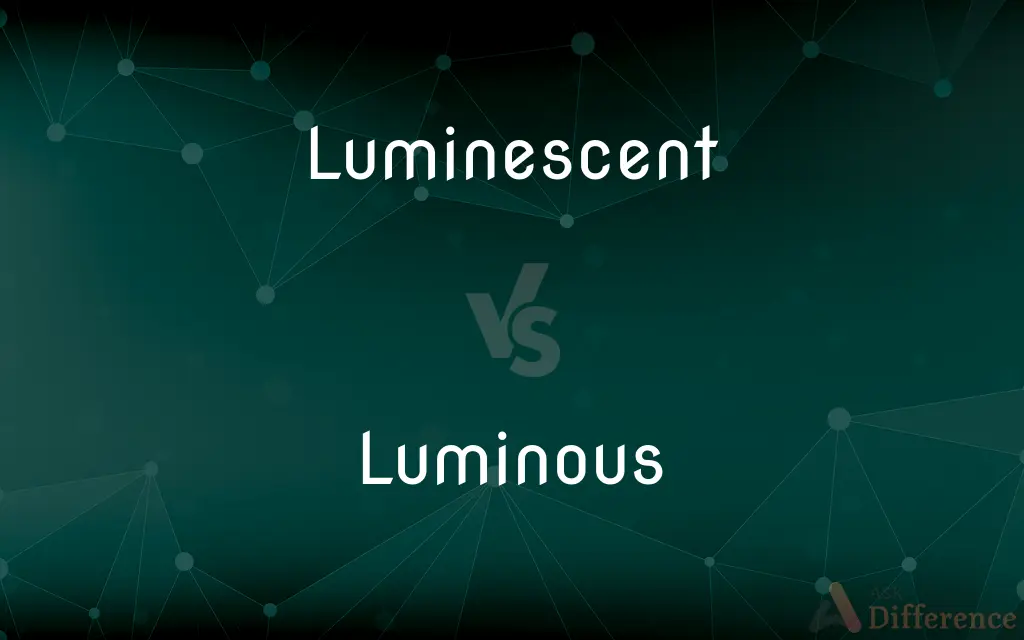Luminescent vs. Luminous — What's the Difference?
By Tayyaba Rehman & Maham Liaqat — Updated on May 6, 2024
Luminescent materials emit light through chemical or physical processes, whereas luminous objects are inherently bright, often due to heat.

Difference Between Luminescent and Luminous
Table of Contents
ADVERTISEMENT
Key Differences
Luminescence refers to the emission of light by a substance not resulting from heat; it includes various forms like chemiluminescence, bioluminescence, and photoluminescence. Whereas, luminous objects emit light primarily because they are hot, such as stars, including the sun, and light bulbs.
Luminescent materials can emit light in various colors depending on the energy released during the light-emitting process. On the other hand, luminous objects often emit a white or yellowish light, correlating closely with their temperature, indicating the heat intensity of the object.
The light from luminescent sources often appears momentarily or under specific conditions, like ultraviolet light exposure or chemical reactions. In contrast, luminous objects typically provide a continuous light output as long as they remain sufficiently hot.
Luminescent light is usually cooler, and handling luminescent materials generally poses less risk of burns or heat damage. On the other hand, luminous objects, due to their heat emission, can be hazardous and require careful handling to avoid injuries.
The process of luminescence does not rely on an object's temperature but on molecular or electronic transitions. Whereas, the luminosity of an object is directly tied to its thermal state, with the intensity of light increasing with temperature.
ADVERTISEMENT
Comparison Chart
Source of light
Chemical or physical processes
Heat
Typical colors
Varies (blue, green, red, etc.)
Often white or yellow
Duration of light
Often temporary or condition-dependent
Continuous while hot
Heat generation
Minimal or none
Significant, related to light emission
Dependency
On specific conditions
On temperature
Compare with Definitions
Luminescent
Related to light emission by living organisms.
Some mushrooms are luminescent, emitting a soft green glow at night.
Luminous
Radiating or reflecting light brightly.
The moon is luminous because it reflects the sunlight.
Luminescent
Showing light emission without significant heat.
Glow sticks are luminescent through chemiluminescence.
Luminous
Brightly shining, especially from heat.
A luminous coal in the fireplace provided a soft glow.
Luminescent
Involving light release by energy transition within atoms.
Phosphorescent materials are luminescent and can re-emit absorbed light over time.
Luminous
Related to visible light emission by a hot object.
Incandescent bulbs are luminous due to the heated filament.
Luminescent
Capable of emitting light by processes other than heating.
Fireflies are luminescent, glowing through a chemical reaction.
Luminous
Pertaining to high levels of brightness from an object.
The stars are luminous points in the night sky.
Luminescent
Emitting light after energy absorption.
Fluorescent paints are luminescent and glow under black light.
Luminous
Emitting light as a result of being heated.
The wires in a toaster become luminous when hot.
Luminescent
Capable of, suitable for, or exhibiting luminescence.
Luminous
Emitting light, especially in the dark; shining.
Luminescent
Emitting light by luminescence.
Luminous
Reflecting light; illuminated
"He watched a luminous cloud drifting up from the Gulf" (Tim Gautreaux).
Luminescent
Shining with a light due to any of the various causes which produce luminescence.
Luminous
Having a high degree of saturation
A luminous green.
Luminescent
Emitting light not caused by heat
Luminous
Presented or perceived clearly or vividly
Luminous memories.
Luminous
Enlightened or intelligent
Luminous ideas.
Luminous
Emitting light; glowing brightly; shining.
Luminous
Brightly illuminated.
Luminous
Clear; enlightening; easy to understand.
A luminous explanation
Luminous
Shining; emitting or reflecting light; brilliant; bright; as, the is a luminous body; a luminous color.
Fire burneth wood, making it . . . luminous.
The mountains lift . . . their lofty and luminous heads.
Luminous
Illuminated; full of light; bright; as, many candles made the room luminous.
Up the staircase moved a luminous space in the darkness.
Luminous
Enlightened; intelligent; also, clear; intelligible; as, a luminous mind.
Luminous
Softly bright or radiant;
A house aglow with lights
Glowing embers
Lambent tongues of flame
The lucent moon
A sky luminous with stars
Common Curiosities
What is an example of a luminescent device?
Glow-in-the-dark stickers are an example of luminescent materials used in everyday life.
What makes an object luminescent?
An object becomes luminescent through chemical reactions, biological processes, or physical phenomena, not involving heat.
Are all luminous objects hot?
Yes, luminous objects emit light as a direct result of high temperatures.
Do luminescent materials emit heat?
Luminescent materials emit very little to no heat when they glow.
Can luminescent light be visible in daylight?
Luminescent light is often less visible in bright conditions, unlike luminous light which can be seen clearly regardless of ambient light.
Is a burning candle luminous or luminescent?
A burning candle is luminous, as it emits light due to the heat generated by the flame.
Can luminescence occur in total darkness?
Yes, luminescence can occur in total darkness, which is often when it is most noticeable.
Is the sun luminescent or luminous?
The sun is luminous, emitting light due to its extremely high temperature.
Are LED lights luminescent or luminous?
LED lights are considered luminescent because they emit light through electroluminescence, not heat.
How do luminous objects produce light?
Luminous objects produce light by incandescence, which is light emitted from heat.
Can luminescent materials light up indefinitely?
No, luminescent materials require specific conditions to emit light and can stop once the conditions are no longer met.
What is the main difference in light emission between luminescent and luminous objects?
Luminescent objects emit light through physical or chemical processes without heat, whereas luminous objects emit light due to heat.
Why do some animals exhibit luminescence?
Some animals are luminescent for reasons such as attracting mates, deterring predators, or luring prey.
Which is more energy efficient: luminescent or luminous lighting?
Luminescent lighting is typically more energy-efficient as it does not involve heat production.
What practical applications do luminescent materials have?
Luminescent materials are used in emergency signs, watches, and medical imaging, among others.
Share Your Discovery

Previous Comparison
Delectable vs. Delicious
Next Comparison
Carton vs. PackAuthor Spotlight
Written by
Tayyaba RehmanTayyaba Rehman is a distinguished writer, currently serving as a primary contributor to askdifference.com. As a researcher in semantics and etymology, Tayyaba's passion for the complexity of languages and their distinctions has found a perfect home on the platform. Tayyaba delves into the intricacies of language, distinguishing between commonly confused words and phrases, thereby providing clarity for readers worldwide.
Co-written by
Maham Liaqat















































